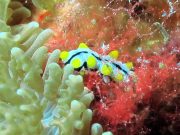Dykning med Holothuriidae Søagurker
Koh Lantas Marineliv | Holothuriidae
Holothuriidae-familien består af cirka 185 søpølser, hvoraf vi kan finde flere i overflod, når vi dykker fra Koh Lanta.
Holothuriidae-søpølser har tykke kødfulde kroppe, der varierer fra små til meget store, ofte dækket af små afrundede fremspring kendt som papiller. Alle arter har mange rørlignende fødder på underkroppen, og flere arter har 15-30 orale tentakler.
Når de bliver stressede eller angrebet, er mange medlemmer af denne familie i stand til at udstøde mange fine, klæbrige, hvide tråde fra deres anus, kendt som Cuvierian Tubules. Disse rør kan vikle sig ind i et rovdyr og gøre det uarbejdsdygtigt. Trådene kan løsnes indvendigt og derefter vokse ud igen inden for 2-4 uger.
Afhængigt af arten kan søpølser være skjult under sten og murbrokker, begravet i sand, ligge frit fremme eller i nogle tilfælde bevæge sig aktivt rundt på et koralrev med deres rækker af klæbrige rørfødder. Nogle få arter er aktive om dagen, men de fleste er aktive om natten.
4 arter fundet på denne side:
Elephant trunkfish
(Holothuria fuscopunctata)
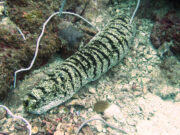
Holothuria fuscopunctata @ Koh Haa
The Elephant trunkfish is a large sea cucumber with a thick body wall, generally golden-brown with dark spots and dark brown wrinkles along its entire body length.
The underside is whitish, the mouth being surrounded by twenty thick brown tentacles and the anus surrounded by a black band.
This sea cucumber can reach up to 70 cm and can weigh up to 4.5kg, though it’s spotted around Lanta more commonly in the 30 - 50 cm range.
This species is normally found down to 30 m, is slow to mature and has a low fertility rate.
Graeffe's Sea Cucumber
(Pearsonothuria graeffei)
The Graeffe's Sea Cucumber is one of the most common sea cucumbers encountered at the dive sites around Koh Lanta. This species of sea cucumber has a white body, with many light, thorny projections surrounded by pale brown blotches. There are many small dark spots all over the body and hundreds of small tube feet on the lower body.
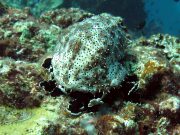
Adult Pearsonothuria graeffei @ Koh Haa
Around the mouth are around 20 - 24 tentacles comprising black stalks with leaf-like ends. The leaves are black on the top and white on the bottom and help to ‘feel’ the way around the coral reef.
This species grows up to 30 cm, are very light-weight and are very thin-walled and ‘floppy’ if picked up (we have rescued some from a fishing trap, but do not recommend touching any marine life in the course of a normal dive).
Small juvenile Graeffe's Sea Cucumbers mimic the phyllidiid sea slug Phyllidia varicosa for protection (many nudibranchs are poisonous and distasteful to predators), and as they grow larger than the nudibranch they are impersonating, they start to take on the adult sea cucumber colouration and form. (see photos)
Pinkfish Sea Cucumber
(Holothuria edulis)
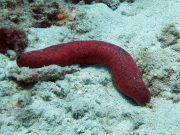
Holothuria edulis @ Koh Rok
The Pinkfish Sea Cucumber has a reddish-pink cylindrical body with rounded ends. There is sometimes a black area on the back/upper body, however this species can also be other colours, such as grey or dark brown.
The lower body has rows of small tube feet which help with movement, and which can be retracted into the body if necessary.
There are around 20 oral tentacles which can help with feeding, movement and also righting itself if it is overturned.
The Pinkfish Sea Cucumber grows to 35 cm and is found over sand and rubble is shallow areas of coral reefs.
Blue Sea Cucumber
(Actinopyga caerulea)
The Blue Sea Cucumber has a loaf-shaped body with some tapering toward each end. The body colour is mostly bluish, with white patches. The bluish areas are covered with small conical 'papillae', which are absent in the white areas.
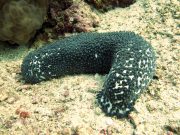
Actinopyga caerulea @ Koh Haa
The mouth of a Blue Sea Cucumber is on the bottom, surrounded by 15 to 18 large bluish-grey tentacles, which in turn are surrounded by a collar of bluish papillae.
The anus of the Blue Sea Cucumber is at the rear end, surrounded by 5 white anal teeth.
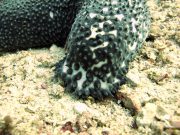
Actinopyga caerulea @ Koh Haa
Unlike many other members of the family Holothuriidae, the Cuvierian organ is absent in Blue Sea Cucumbers and this species is unable to eject Cuvieran tubules if stressed.
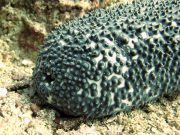
Actinopyga caerulea @ Koh Haa
Dykning med Holothuriidae Søagurker omkring Koh Lanta
Dykning og snorkelture
Hvis du gerne vil have chancen for at se Holothuriidae Søagurker på en af vores daglige dykkerture i højsæsonen fra Koh Lanta, så send os en e-mail til info@diveandrelax.com.
Deltag i vores speedbådsdykkerture i højsæsonen til nogle af Thailands bedste dykkersteder og nyd små grupper, korte rejsetider med fokus på god personlig service, sikkerhed og sjov.
Er du endnu ikke certificeret dykker? Lær at dykke på Koh Lanta med det 3-dages SSI Open Water Diver-kursus.
Book online og spar 10% på dykkerture og dykkerkurser på Koh Lanta.
Få mere at vide
Indo-Stillehavets havdyrsguider
- Allen, G., Steene, R., Humann, P., DeLoach, N. (2003) Reef Fish Identification, Tropical Pacific. Jacksonville, FL., USA: New World Publications, Inc., ISBN 1-878348-36-1.
- Humann, P., DeLoach, N., (2010) Reef Creature Identification, Tropical Pacific. Jacksonville, FL., USA: New World Publications Inc., ISBN 978-1-878348-44-9
- Debelius, H. (2013) Indian Ocean Reef Guide. Frankfurt, Germany: IKAN - Unterwasserarchiv, ISBN 978-3-939767-52-7.
- Debelius, H. (2004) Nudibranchs and Sea Snails, Indo-Pacific Field Guide. Frankfurt, Germany: IKAN - Unterwasserarchiv, ISBN 3-925919-51-1
- Erhardt, H., Knop, D. (2015) Corals Indo-Pacific Field Guide. Frankfurt, Germany: IKAN - Unterwasserarchiv, ISBN 3-925919-69-4.
- Veron J.E.N., Stafford-Smith M.G., Turak E. and DeVantier L.M. (2016). Corals of the World
Flere referencer om havets dyreliv og yderligere information


